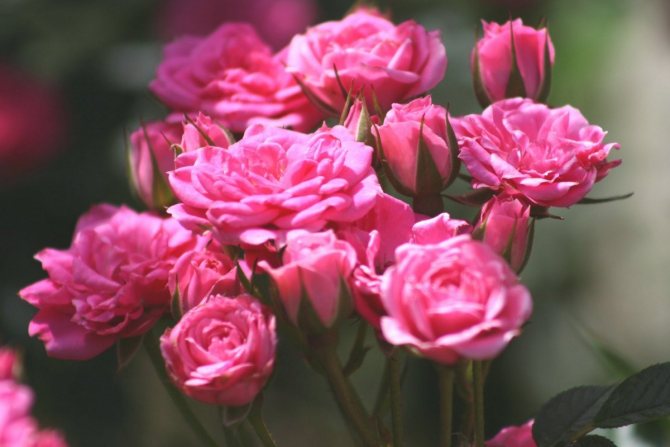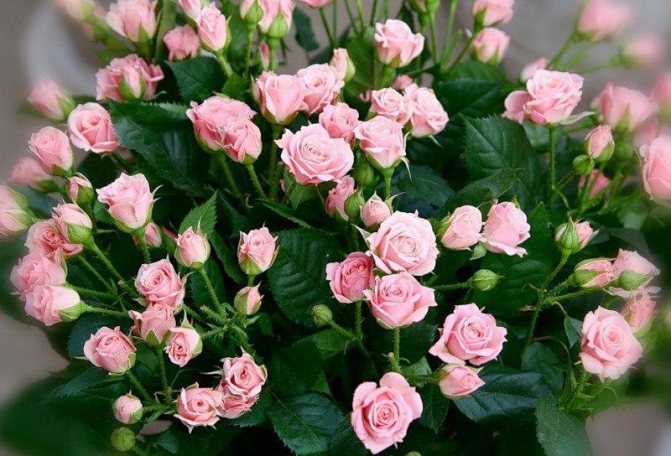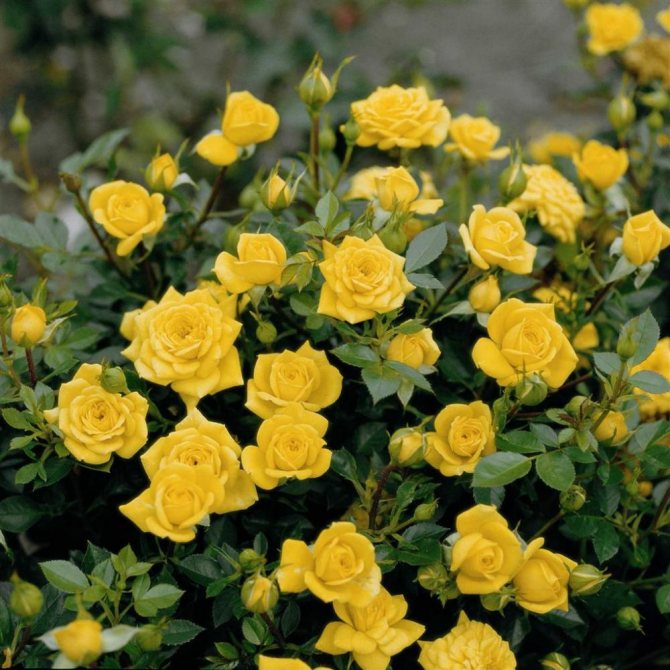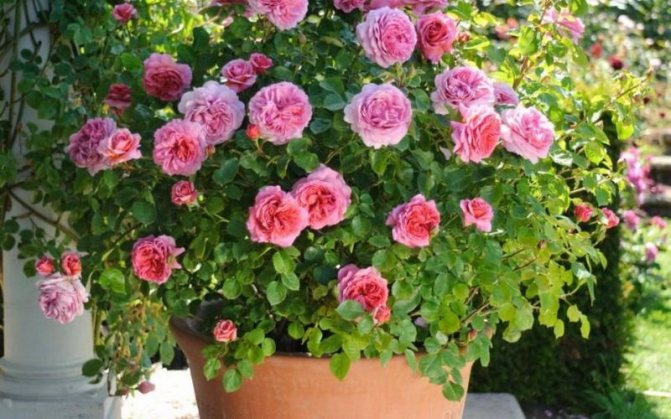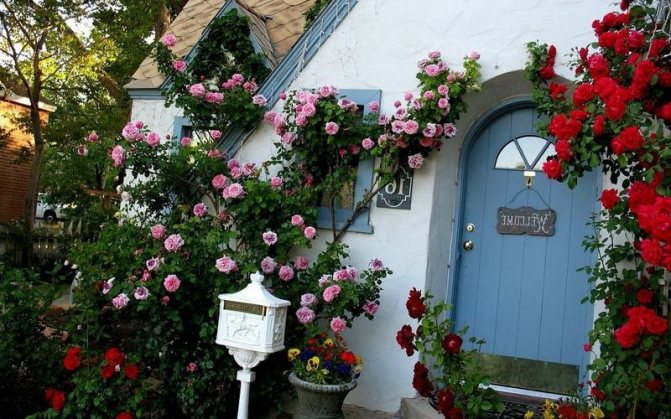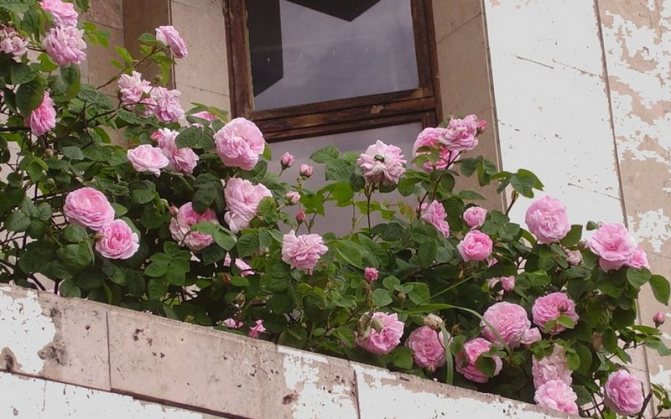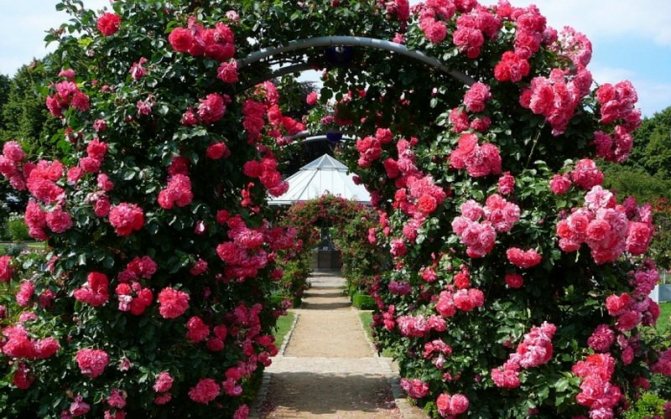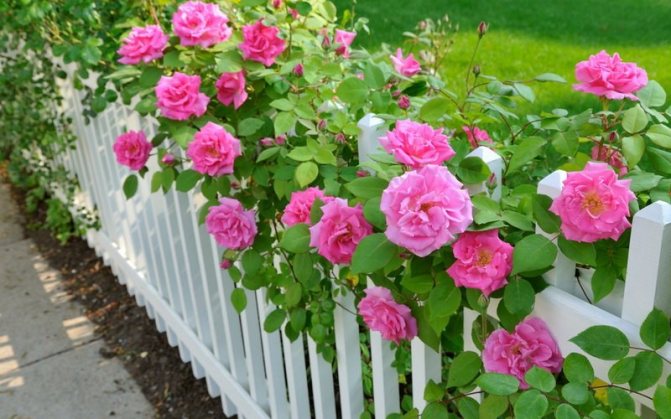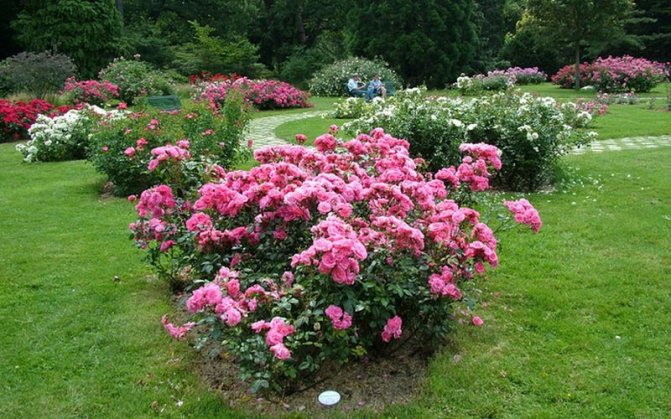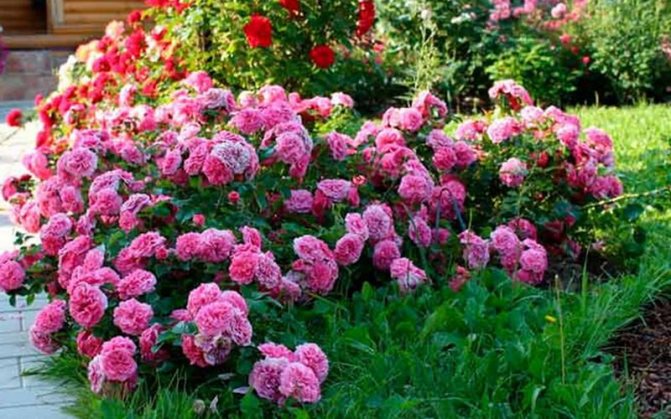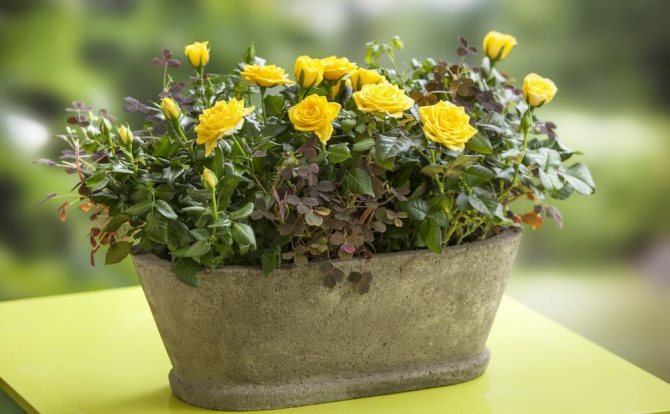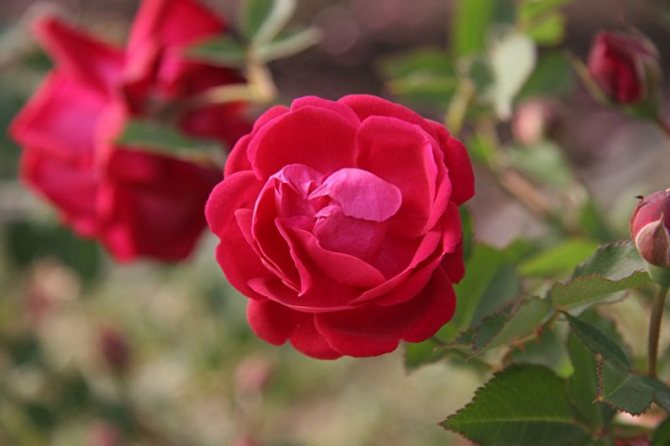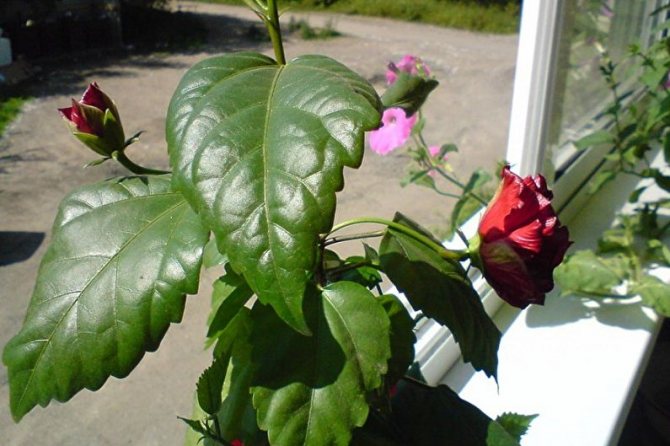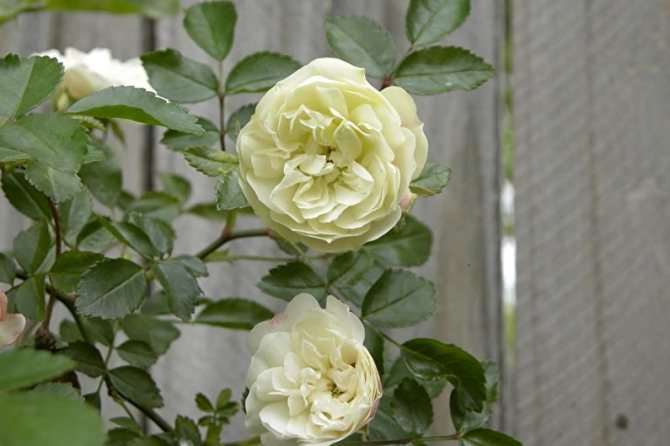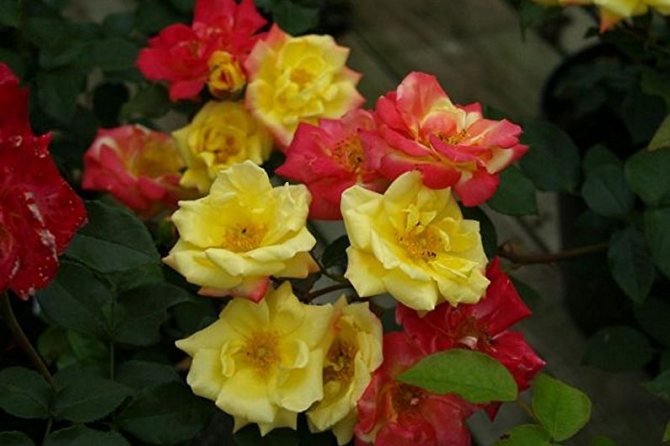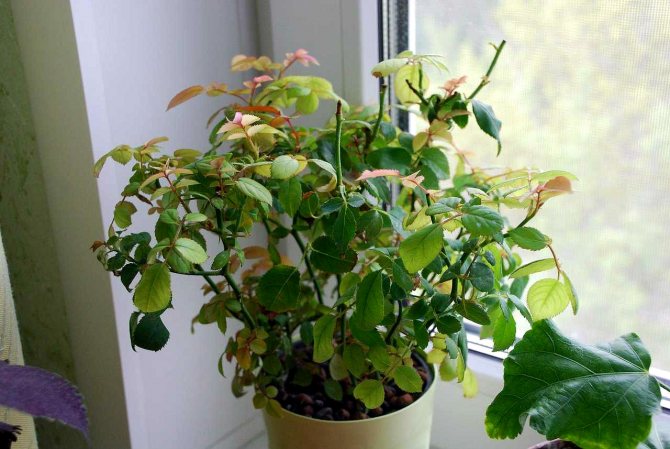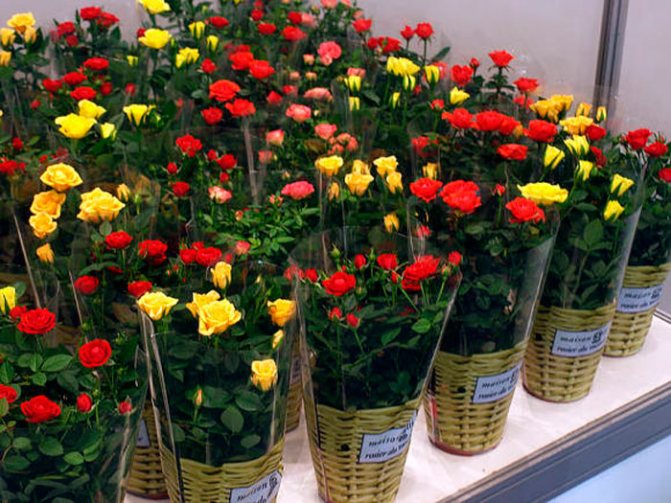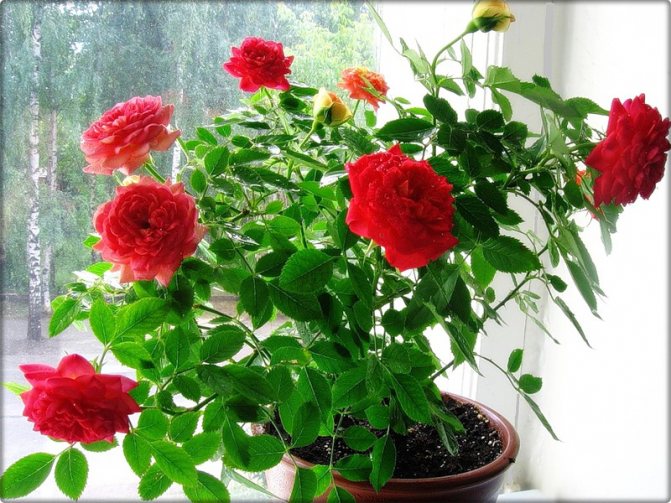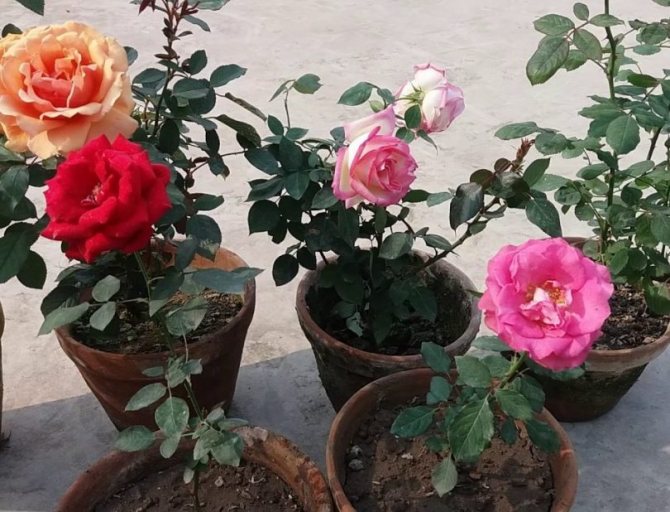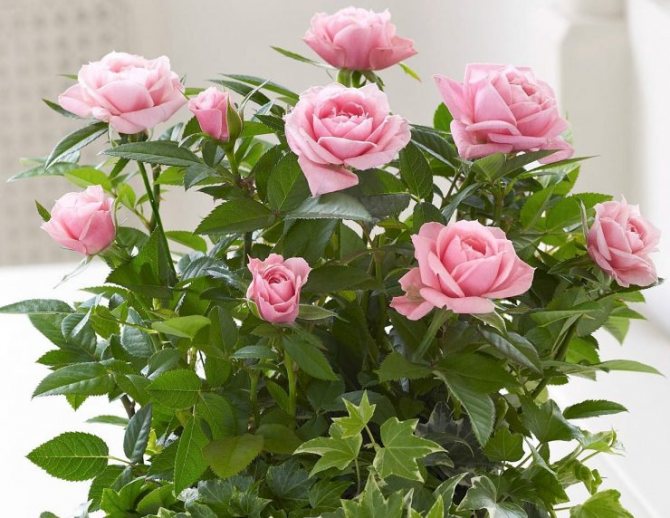- the main
- The best miniature roses for the Moscow region
Oct 15
no responses.
The beauty of a home cannot be imagined without a well-kept garden and a luxurious flower garden. And to emphasize the luxury of flower plantings, seedlings of miniature roses will help. You can buy them in an assortment of varieties in our nursery. And we will tell you about the most popular and noteworthy ones below.
The beauty of miniature roses will highlight your site
Description of miniature roses
Miniature roses are in no way inferior to their classic relatives. They are famous for their abundant flowering and a beautiful bush, always densely covered with graceful foliage. They, like large, "real" roses, can have a varied shape and color of the flower. Among the miniature roses there is even a blue rose 'Lavander Jewel', a variety with a greenish tint - 'Green Ice' - and another, no less original - 'Stars and Stripes' (' Stars & Stripes'). Its flowers are large, white with red stripes. Some "babies" are distinguished by an unusually delicate, delicate aroma. For example, such varieties as 'Lavander Lace', 'Sweet Fairy'.
Bushes of miniature roses are usually 15-25 cm tall. True, sometimes old plants reach 40-45 cm. Flowers in "miniatures" are 1.5-2 cm in diameter, single or collected in inflorescences. One of the smallest varieties is the ‘Yellow Bantam’ humpy yellow rose. To date, hundreds of varieties of miniature roses have been bred. They can have a wide variety of garden shapes - from standard to climbing.
Among the climbing mini-roses, the ‘Hi-Ho’ and the ‘Red Cascade’ varieties deserve attention. They bloom on the shoots of both the previous and this year. ‘Hi-Ho’ has the original coral red color of flowers, ‘Red Cascade’ has an unusually abundant flowering. By the way, the lashes of these miniature roses can reach a meter in length.
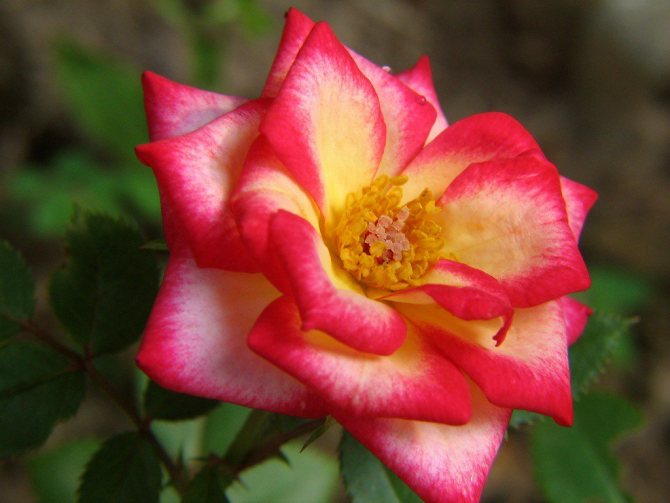
Miniature rose (Rosa minima). <>
Description and photos of popular varieties
Low-growing roses are very widely used for decorative purposes, to decorate city flower beds and borders, a garden plot and rockeries... Balconies are decorated with miniature roses, they are planted in indoor pots and grafted onto stems.
Maidy
The bush is of medium height (up to 35 cm), grows compact, has dense dense foliage. Terry flowers, up to 5 cm in diameter, pointed petals. The aroma of the rose is not strongly pronounced... The color is two-tone - the middle is white, the edges of the petals are dark red. The bushes bloom throughout the season, frost resistance is medium... The weak point of the plant is its vulnerability to black spot.
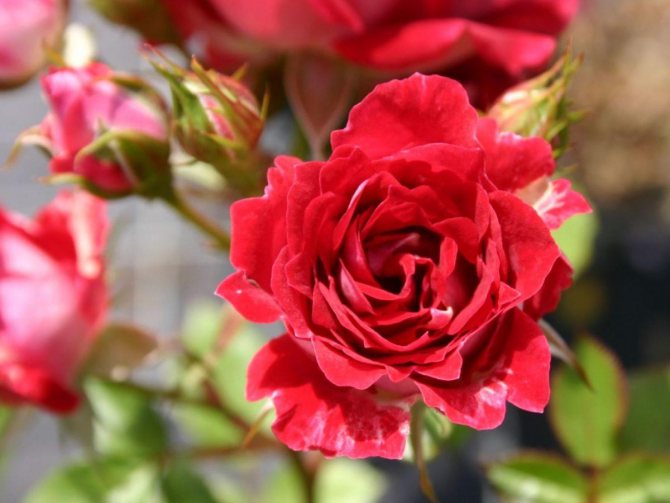

Mandarine
Mandarin rose lives up to its name with its rich, bright orange petals. The buds are medium in size and bloom several times per season. The foliage of the plant is small, like the bushes themselves. Perfect for border planting in a group with other flowering low-growing plants.
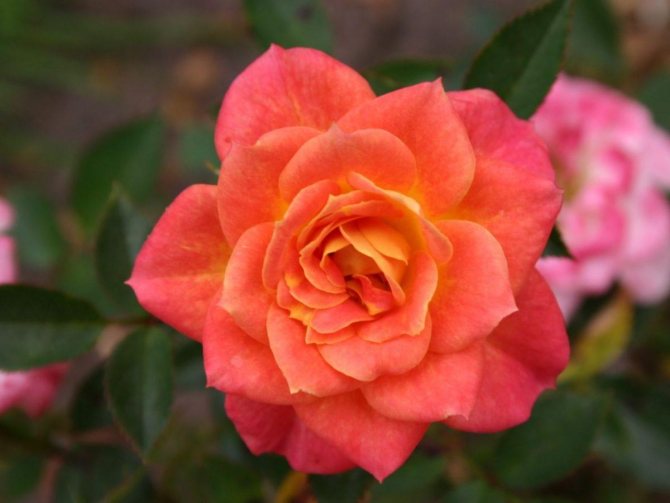

Mr. Bluebird
The miniature Bluebird rose is quite unusual. Small buds (3-4 cm each) densely "inhabit" the branches of the bushes, which can reach a height of up to 50 cm. The color of the petals is lilac with a light and delicate pink tint. The buds are collected in inflorescences of 10-15 roses. There is no aroma. Gives color until the first frost.
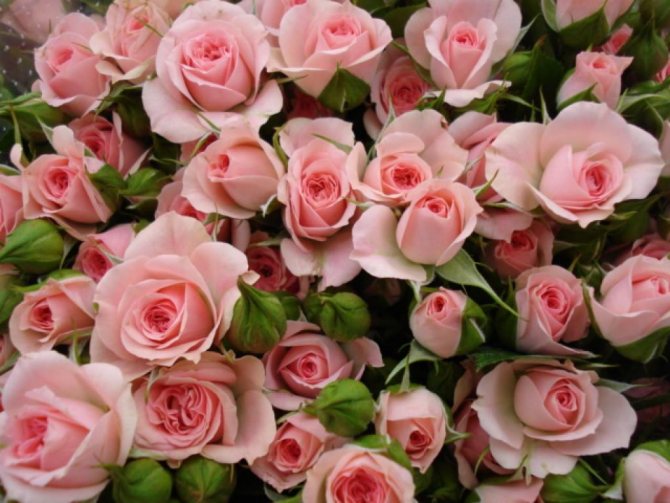

Rouletii
This variety is quite old and is very much loved by landscape designers. The bushes are straight, not spreading, up to 40 cm high. The foliage is small, like the buds (2-4 cm). The shape of the flowers is cupped, in the inflorescence there can be up to 25 buds. The color of the roses is mixed: mauve and a little fuchsia. The plant is very fragrant, unpretentious to care for, but is afraid of powdery mildew.
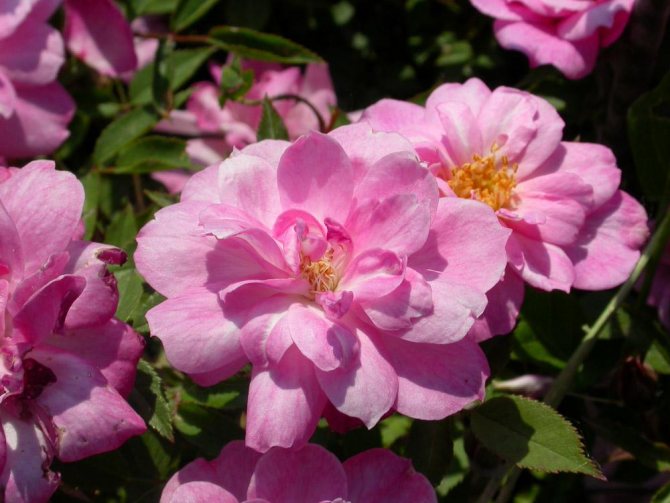

Fresh pink
It is these small bush roses that are resistant to fungal diseases., therefore, are widely used for planting in conditions of minimum possible care. The buds are cupped, the color of the petals is light pink, in inflorescences up to 12 flowers. Flowering lasts from May to October. They bloom profusely in the spring.
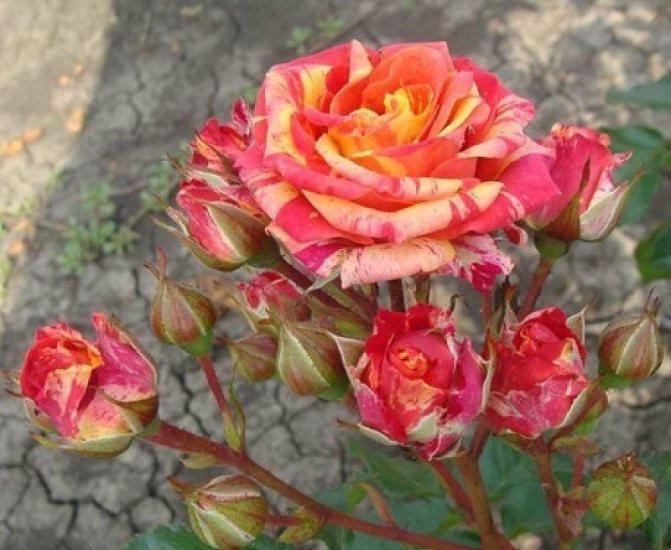

Kapelka
Rose Drop impresses with a rich red color, and the fact that its shoots are perfectly woven along the arch makes the flower in demand among designers and gardeners. Bushes Droplets are wide spreading, the buds are rather large, as for a small rose - up to 10 cm... The aroma is weak, but perceptible. Blooms all season until late autumn. It survives frosts well both in the southern and in regions with a cool climate.
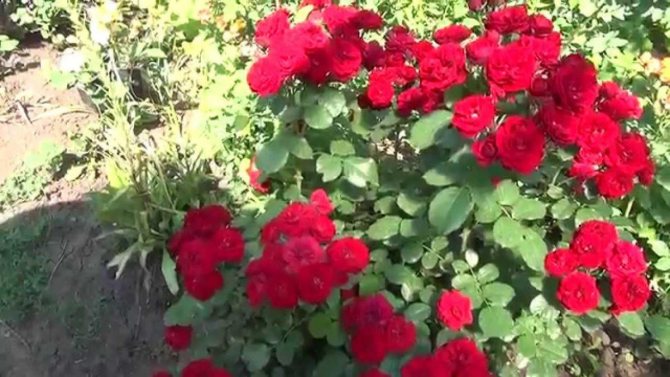

Gold symphonie
This variety grows in compact bushes up to 40 cm high. Double flowers are medium - up to 6 cm, painted in a golden yellow hue. They bloom early - in the first decade of May, flowering is long - until late autumn. Suitable for any landscape planting.
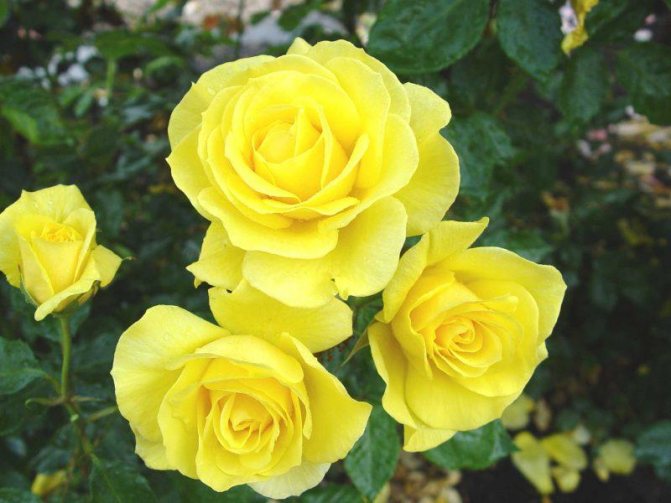

Garnet bracelet
These small bush roses were bred relatively recently. The bushes are low - up to 30 cm, the foliage is characterized by waviness and jagged tips. The petals in the bud are densely planted, so the flower reaches 7 cm in diameter when blooming. Bicolor buds - white and pink. The plant is resistant to diseases, winter-hardy, blooms until late autumn.
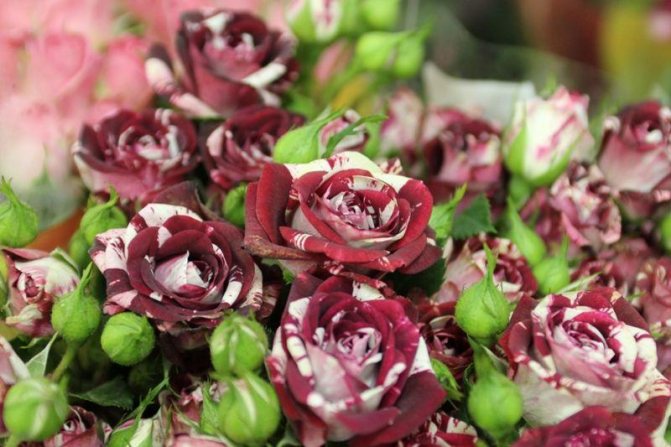

Lavender Meillandina
A very unusual flower in its color and shape. The bushes are medium - up to 50 cm, moderately spreading and, remarkably, absolutely thornless. The foliage is dense, dense. The scent of this small rose is weak, but its beautiful color - lilac-purple, fully compensates for this shortcoming... The plant does not need excessive moisture, watering should be moderate. Easily prone to root rot. It is better to cover the bushes for the winter.
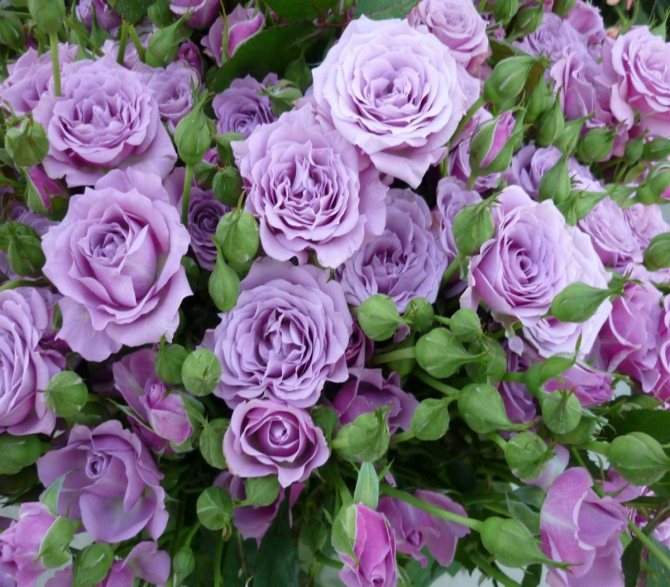

Green ice
Green Ice is a very interesting rose due to its refinement and diminutiveness. The bushes are wide, but low - up to 30 cm. The buds are small (no more than 3 cm), the inflorescences on the branch are also small - 5-7 roses each. Color from milky white at the beginning to greenish at the base. The plant is remontant, it blooms again until late autumn. Afraid of rain, but resistant to other diseases. Feels good both in partial shade and in the sun.
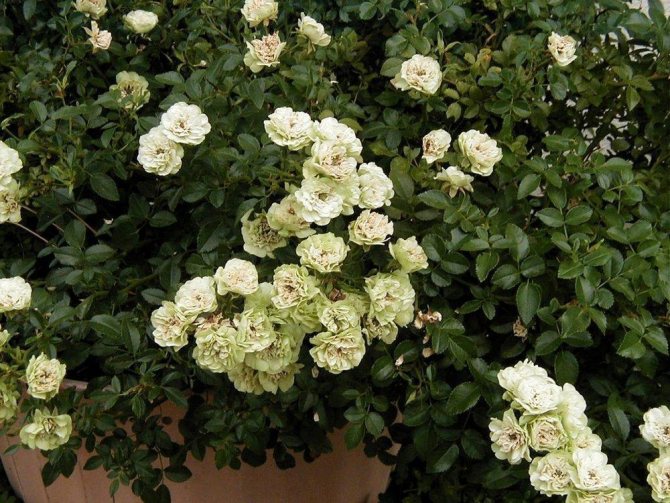

Bigoudi
Not all gardeners like the variegated color of this variety. The color of small buds (up to 5 cm), red with yellow stripes. Perhaps the color is far from aristocratic, but it is quite positive and bright, which means it will decorate any garden bed. The aroma is not pronounced, but the flowering of this small bush rose is long lasting. Buds bloom not earlier than June... You should also protect the plant from fungal diseases, use fungicidal solutions for prophylaxis.
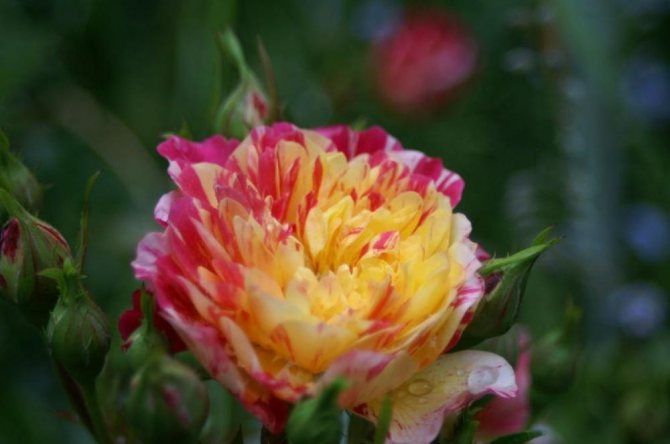

Stars'n Stripes
Beautiful, medium-sized goblet-shaped buds are collected in refined shoots. The color of the petals is red, pierced with delicate pink stripes. Bushes of medium size (up to 40 cm), bloom throughout the summer season. But if the summer is cool and rainy, then the plant can be affected by powdery mildew. The bushes of these roses are generally resistant to other fungal diseases.
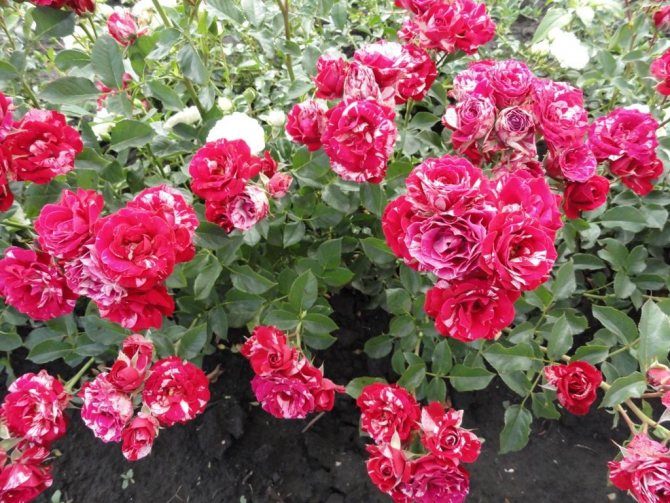

Cinderella
Small roses Cinderella belong to the old varieties. Bushes of medium height bloom profusely all summer. The aroma of flowers is spicy and persistent. There are no thorns on the stems, and the white buds with a pink tint (up to 3 cm in diameter) are collected in compact inflorescences. Novice gardeners should know that this variety is very unstable to black spot.
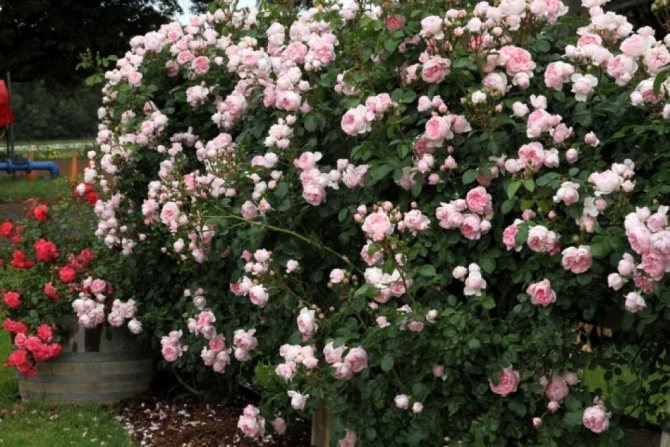

Daniela
Roses with small buds Daniela are a very delicate and refined variety. Bushes are small and compact (up to 20 cm on average). Buds with a diameter of three centimeters are collected in large inflorescences (up to 20 pcs.). The flower petals are slightly pointed. They bloom in a pink shade, and later fade under the influence of the sun. The bushes bloom for a long time and profusely. They are resistant to diseases, but it is better to cover them for the winter.
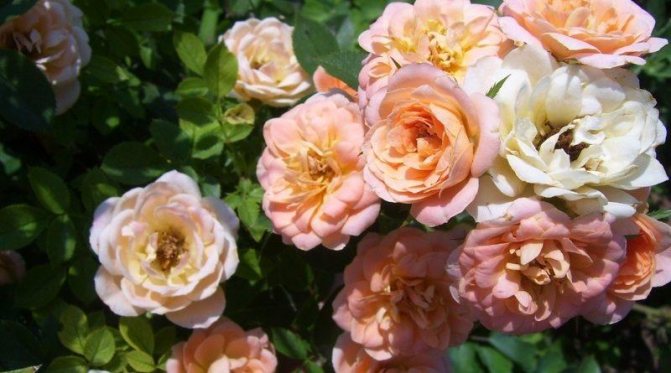

Finger Boy
This variety looks very luxurious in any landscape design: both on boles, and in the design of ridges, borders and as a potted home option. Bushes of medium height, with dense elongated foliage. The flowers are small, cupped, collected in large inflorescences, sometimes up to 100 buds. The plant is highly winter-hardy.
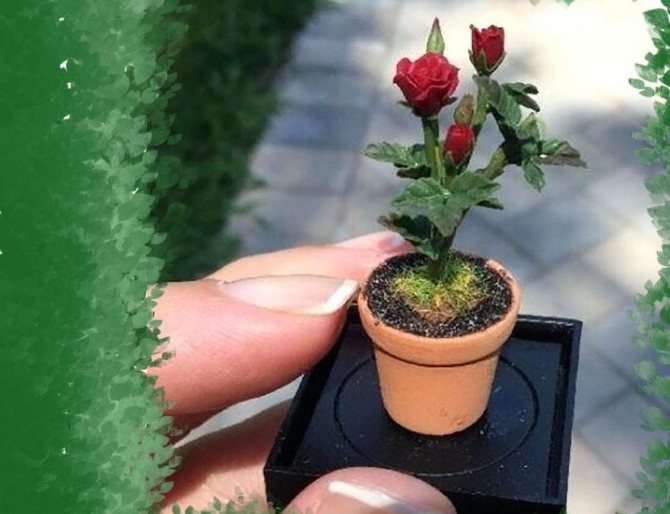

Conditions required for miniature roses
Location
Miniature roses are simple in culture and unpretentious, but in order for them to grow well and bloom profusely, you need to choose an area protected from northern winds and always sunny (especially in the morning). The morning sun promotes rapid evaporation of moisture from the leaves and thereby prevents the disease of plants with powdery mildew and rust.
Soil for miniature roses
Roses grow on all types of soil, but loams with good water retention capacity and weak acidity (pH 5.8–6.5) are considered the best for them. Not all areas can provide ideal conditions for growing these flowers. Therefore, we must try to at least minimize the existing unfavorable factors. On dry sandy soil, roses grow and bloom poorly, therefore, when planting, 2-3 buckets of a mixture of humus and clay, taken in equal quantities, should be placed in each hole.
On clay and damp areas, 2-3 buckets of humus are introduced into the planting pit, mixed in half with sand. 300-400 g of lime, 400-500 g of bone meal or 40-50 g of superphosphate, 150-200 g of wood ash are added per 1 m2 and all this is mixed well. And if your site is flooded with water in spring or autumn, then drainage is needed.
Pros and cons of growing at home
The most important advantage is that rose flowers will delight their owner almost all year round.
The main disadvantages include time and patience during the growing process. The decorative home rose is very sensitive and capricious and, depending on the season, the requirements for care change.
[collapse]
Planting miniature roses
When planting in the ground, the plants are buried 3-5 cm in the soil. The distance between miniature roses is 20-25 cm. When planting thickened, the plants shed their lower leaves. Plants are planted only in spring, so that a good root system can develop by winter, otherwise the roses risk freezing out. The first time is covered with non-woven material so as not to get burnt. Weak frosts will not harm roses.
Plants in the ground can be planted both in pots and without them... At the time of abundant flowering, you can transplant the rose again into a container and bring it into the house, onto a terrace or balcony, but in this case, in the fall, it will have to be taken from the ground for wintering. Only roses planted without pots in the soil in spring can be left for the winter.
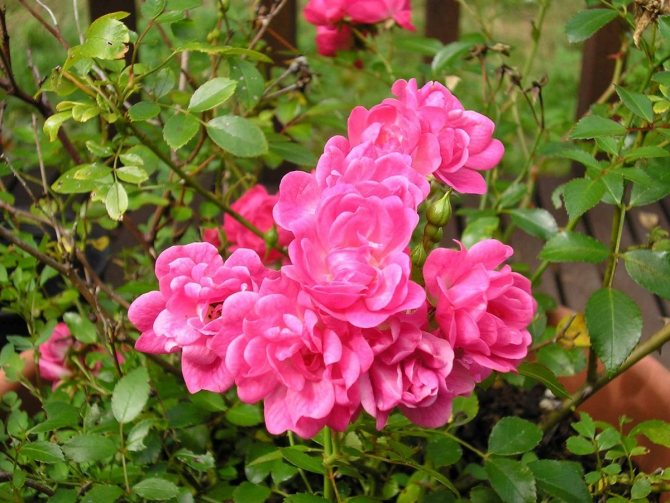

During the summer, miniature roses need to be watered and fed.
Use in landscape design
Miniature or dwarf roses are actively used to decorate gardens, parks and any other areas. These shrubs can be grown both outdoors and in pots.
They can be planted in flower beds, curbs, alpine slides and other compositions. If the plant grows in a container, then it can be a wonderful decoration for a veranda or gazebo.
Dwarf roses are very often cut and used as a boutonniere.
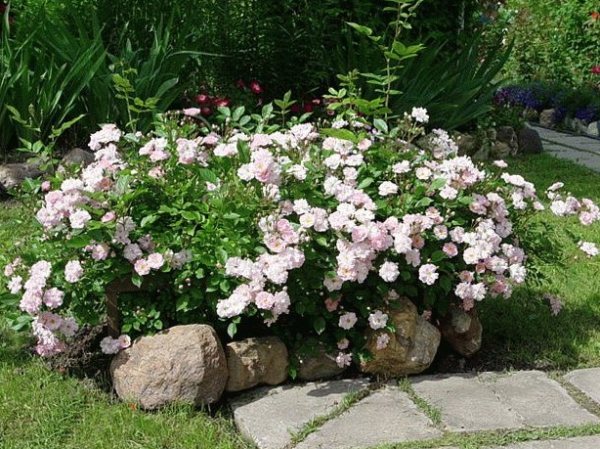

Miniature or dwarf roses are actively used to decorate gardens, parks
Caring for miniature roses
During the summer, miniature roses need to be watered and fed.... During the season, at least 3-4 feeding is required.In the first half of the growing season, mainly nitrogen fertilizers are applied, and in the second half, phosphorus-potassium fertilizers. The first feeding with urea or ammonium nitrate is carried out in early spring, after removing the shelter and pruning. As shoots and leaves grow back, nitrogen fertilization is repeated. When buds appear, the plants are fed with full mineral fertilizer. In August, superphosphate and potassium nitrate should be added from the dressings. The soil around the bushes must be constantly kept loose so that a crust does not form, which interferes with the access of air and water to the roots.
Works well on roses planted in the garden by spraying in the morning and evening or watering with a hose with a spray of water... This procedure prevents pests and cleans the plant. However, when watering, roses should not be poured, since they are quite drought-resistant and do not like waterlogging of the soil. In cloudy weather, spraying, on the contrary, slows down growth.
If a rose hibernates outdoors
In central Russia, miniature roses require shelter for the winter... There is no need to rush to shelter roses, miniatures tolerate frosts down to -7 ° C well, besides, they help the plants prepare for winter. Roses should be covered with the onset of persistent cold weather. The leaves are not cut off from the plants, only the flowers are removed and the tops are cut, on which there are no sleeping buds, but only one peduncle.
It is undesirable to huddle the bushes with peat, sawdust or sand. Peat acidifies the soil, sawdust absorb moisture, sand forms a hard lump. Spruce branches are best suited for sheltering roses. It is laid between bushes and on top of plants. After shelter, wire frames are installed on the bushes. They should be 20-30 cm higher than the plants. Insulation material is placed on the frame, and a plastic wrap is stretched on top.
In the spring (in March-April), the roses must be aired by opening the sides of the frame.... It is important to remove the top film as early as possible, otherwise the temperature under it will rise greatly, and the kidneys will start growing ahead of time. And since the roots do not work in dead soil yet, the aboveground part of the plant may dry out. Roses remain under the non-woven fabric for some time, getting used to the sun. The foil is removed as soon as the edges of the film thaw. Miniature roses hibernate under such a shelter very well, often last year's leaves remain green and continue to work for the plant in the spring.
In the south of Russia, covered roses do not even shed their foliage for the winter and in the spring, after removing the shelter, they start growing faster, they bloom earlier.
To get a flowering plant for the winter and spring holidays, you can leave the rose pot in the ground, carefully covering it, and in the middle of winter bring it into a room with a temperature of 3-10 ° C and cut the stems half the height. After 1-2 weeks, add a rose to the room and start fertilizing and highlighting to stimulate the rapid formation of new shoots and buds.
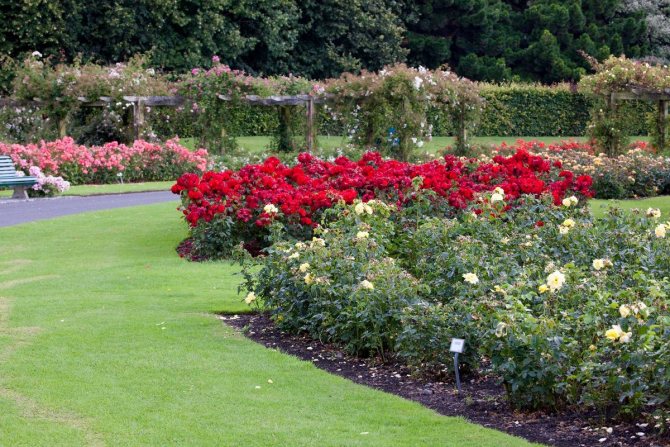

Miniature roses in the garden.
If a rose hibernates indoors
After flowering, roses are transplanted from the ground (into pots), but they are not brought into the room, but left outside, in the shade... Transplanted flowers need to be sprayed frequently, but watered sparingly.
It is best to replant roses from the ground in August.... Such plants have time to take root before winter, winter well and bloom well in spring. For transplanting for the winter, not too large pots are taken, since in large ones the ground remains wet for a long time, and if it is cold in the room, it can turn sour and the rose will die.
From late September to early October, leaves will begin to fall off the plants. It happens that the leaves do not fall off the bushes, then they need to be cut off on their own, at least partially. If it is possible to place roses in a cool room for the whole winter, this is ideal.... Light doesn't matter.An unheated garage or cellar, a glazed loggia is perfect. Watering is minimal. You can only occasionally slightly moisten the earthen lump, but do not allow it to completely dry out.
Already from mid-February - early March, you can interrupt the rest period for roses... To do this, if the plants were in a dark place, they are taken out into the light, pruned and necessarily transplanted, mineral and organic fertilizers are applied. Rested plants bloom beautifully all summer, both in the room and on the balcony.
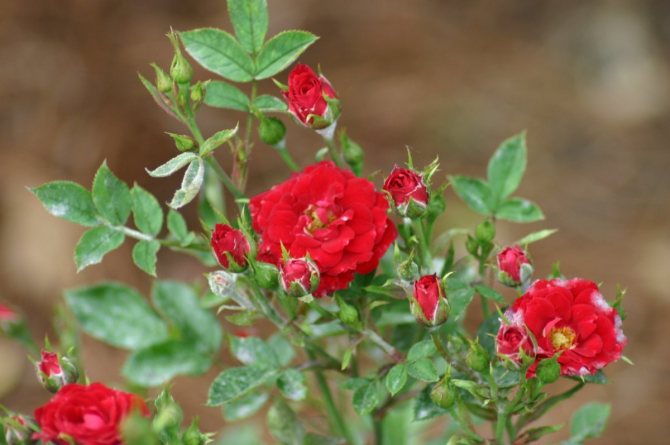

In the first year, miniature roses do not bloom too abundantly, but in the second year they will appear before you in all their glory.
Care and fertilization rules
The home rose is in an artificial environment, so it needs careful care. To keep the bush always healthy and bloom luxuriantly, place the plant pot in a well-lit place where the light is bright, but diffused. For the even development of the crown, it is very important that the bush is illuminated from all sides. This condition is met if the plant is turned every week, or illuminated with lamps. Cold and drafts are harmful to the rose. It is better to be surrounded by a temperature of 18-23 ° C. Air humidity should be moderate (too dry air contributes to the appearance of a spider mite on a rose, humid air leads to the development of fungal diseases). Water the flower with settled water. The frequency of watering depends on the season. In the summer, you may need 2 waterings a day, in the winter, 2 times a week is enough. Top dressing is the key to growing a home rose. To make it bloom profusely, fertilizers are applied 1 time / 2 weeks. It is advisable to alternate mineral fertilizing with organic matter. Best of all, roses absorb liquid fertilizers, which are applied at the root. For spraying the leaves, special fertilizers are used. If the plant is sick, it is not recommended to feed it.
Reproduction of miniature roses
Own-rooted mini-roses do not give wild growth and retain all the characteristics of this variety, therefore the main and easiest way to propagate this group of roses is green cuttings. Indoors, that is, in a greenhouse, the possible dates are the end of March - the beginning of September, in the open - the end of May - July. The middle part of annual shoots is used for cuttings. The length of the cutting should be 10-12 cm, the number of buds should be at least three. The lower cut is made under the kidney, at an angle of 45 °, and the upper cut is 0.5-1 cm higher than the kidney.
The sheet is shortened by half. The knife or blade used to harvest the cuttings must be sharp and clean, they must be disinfected with a weak solution of potassium permanganate or alcohol. At the bottom of the box for cuttings, drainage is laid with a layer of 2-3 cm, consisting of coarse sand, gravel, broken brick or expanded clay, then a layer of nutrient earth 10 cm thick is poured, on top of it - 3 cm of pure river sand or perlite.
For better rooting of roses, a nutrient solution is prepared (for 1 liter of water, 100 mg of a drug, for example, Epin). The cuttings are immersed in a solution for 1/3 of the length and kept in it for 8-12 hours. Heteroauxin can be used. In this case, the end of the cutting is dusted before planting. Cuttings are planted densely, at a distance of 2-3 cm from each other. Arcs are placed over the box and polyethylene is placed on them. This is done in order to maintain high soil and air humidity. The first 20-25 days, the relative humidity should be at least 90%. As the cuttings grow, it is reduced to 70-80%. Callus is formed in 20-30 days, and elastic, sufficiently strong roots - in 40-45.
For the winter, a box with cuttings is brought into a frost-free room.... At the same time, the roses are slightly sprinkled with wet sand. In extreme cases, the box can be buried in the garden at the highest place so that water does not accumulate in the pit. Rooted cuttings are first covered with spruce branches, and then covered with earth. In the first year, miniature roses do not bloom too abundantly, but in the second year they will appear before you in all their glory.
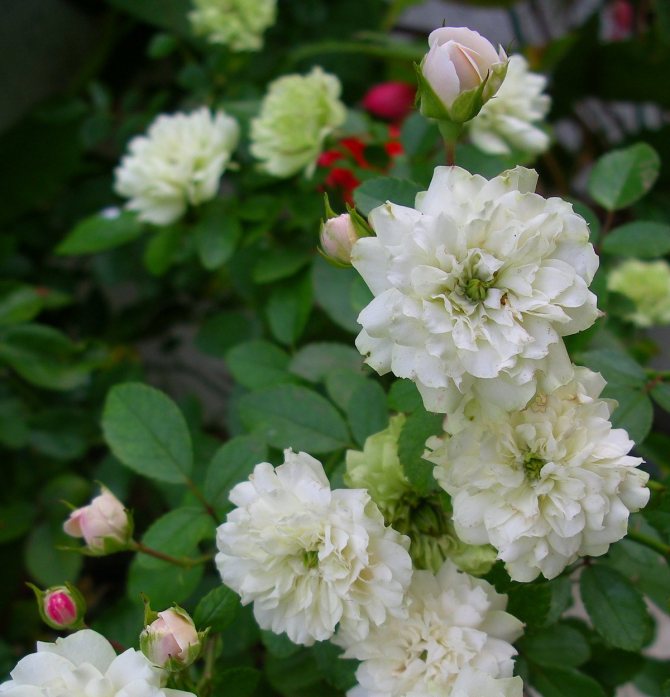

If you have the ability and desire to babysit miniature roses, they will bloom beautifully on the windowsill all year round.
Growing a flower
Rose Monica (Monica) - what kind of cut variety, description
Many flower growers are interested in the question of how to care for a Mix rose after purchase. It should be borne in mind that the pot and peat in which the flower is sold are not suitable for growing it, so the rose has to be transplanted at home.
Important! This procedure is recommended to be done a couple of weeks after purchase so that the flower can adapt to new conditions.
During the adaptation period, it is necessary to control the humidity parameters. After the plant has adapted to the new conditions, you can begin to transplant it. It is recommended to use a ceramic pot with drainage holes for this. Do not use too large a container. It should be 5-7 cm larger than the previous one.
For transplanting a rose, it is better to take a special soil. Experienced flower growers do not recommend making a substrate with their own hands.
Planting procedure step by step:
- It is recommended to cut the buds before transplanting.
- Place a drainage layer on the bottom of the container. Its thickness should be 3 cm.
- Water the plant well, remove from the previous container and place in a new one. At the same time, it is important to preserve the integrity of the earthen coma.
- Fill the resulting voids with soil and tamp it a little.
- Sprinkle the rose with room temperature water.
- Put in a shaded place.
- The next day, the soil can be moistened.
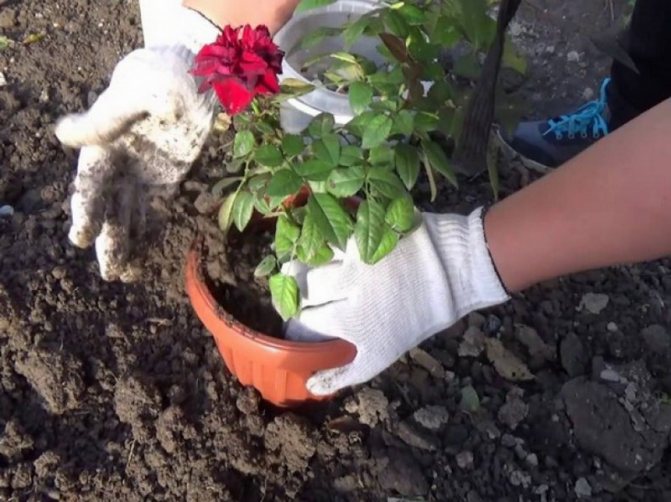

You need to take care of the rose, observing the rules of agricultural technology
Using miniature roses
Miniature roses are so graceful that there is a desire to plant them on the windowsill.... However, in the apartment, these babies do not feel very comfortable due to the dry air and high winter temperatures, combined with short daylight hours. True, Americans consider the miniature rose to be a real houseplant. Indeed, if you have the ability and desire to babysit roses, they will bloom beautifully on the windowsill throughout the year. But for this you need to light up the bushes in winter, constantly spray them from a spray bottle, keep the pots on trays with wet gravel, do not forget to feed the plants and, alas, periodically fight the red spider mite.
At the same time, in the open field, many varieties of miniature roses in central Russia winter well and without mortality, even with a slight cover. They are afraid not so much of frost as of dampness. Therefore, it is better to grow them in the garden in a rock garden or in small raised flower beds. Such flower beds look especially impressive if miniature roses of various bright colors are planted in them.
What is this plant?
Botanical description
Rose mix belongs to the Rosaceae or Rosehip family... This variety was bred by breeders specifically for growing at home.
Features of the
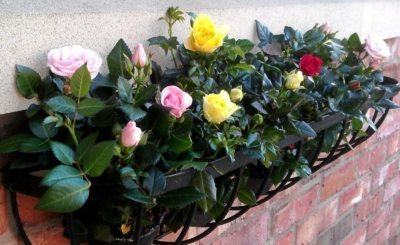

The plant is a small shrub up to 65 centimeters high. The size and color of the buds depends on the variety of the flower. As a rule, this is a miniature rose, endowed with a delicate aroma. This rose variety can bloom several times a year. At the same time, the flowers on the plant retain their color and aroma for a long time.
Diseases and pests of miniature roses
Even good care cannot protect your plants from pests and diseases, so you need to constantly monitor the plantings and take the necessary measures at the first signs of the disease.
Of the pests, roses are most often affected by aphids and spider mites. They suck the juices from the delicate tissues of young leaves and buds, making them dry and fall off. Another scourge of roses is powdery mildew (whitish bloom on shoots, leaves and buds).
With a weak lesion, you can dust the plants with colloidal sulfur powder, with a strong one, spray the bushes with a solution consisting of 20 g of copper sulfate and 200 g of laundry soap per 10 liters of water. Rust infects leaves and stems.If rusty-brown spots are found on the plant, it is necessary to process it with a Bordeaux mixture. The affected parts should be cut and burned.
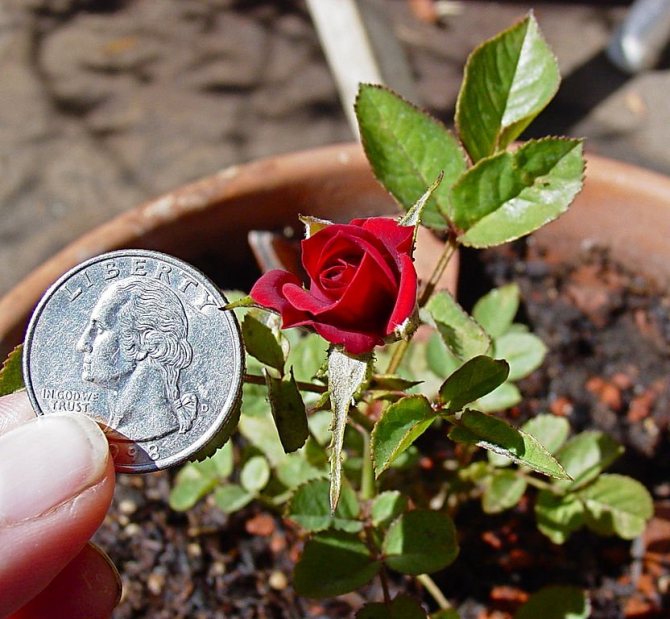

Due to their small size, miniature roses are convenient to use as border plants, for rock gardens, hedges, in a standard form and in a pot culture. <>
Rose mix content errors
If there is drying of the leaves, dropping of buds, a change in the color of the shoots, then the main reason for this is most often insufficient air humidity or watering. To cope with this will help competent regular watering and spraying. If the plant is damaged by pests (it can be aphids, ticks, etc.), the culture should be taken away from the rest. A diseased plant should be sprayed with a special remedy for pests (such as, for example, "Arrow" or "Fitoverm"), or prepare a garlic infusion (170 grams per 1 liter of water, a teaspoon of the ready-made solution, diluted in 1 liter of water and spray ). To combat parasites, bathing the stems and bushes is quite effective (the soil should be isolated from water when bathing by covering the pot with plastic wrap).
Care errors
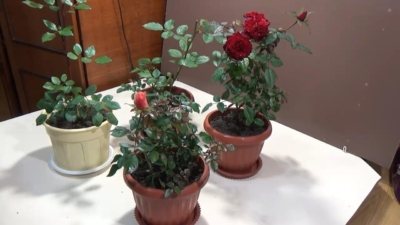

- Dry air can cause drying of leaves, dropping of buds, discoloration of shoots. Correct regular watering, spraying, shower will help.
- Pests... Harm the shoots and the root system, the plant loses leaves, stops blooming. Treatment with special preparations, bathing of stems and bushes will help.
Indoor rose mix, with proper care, is capable of pleasing its owners with abundant and long flowering all year round. Knowing the basic requirements for the content of this plant, it is not very difficult to achieve such a result.
If you find an error, please select a piece of text and press Ctrl + Enter.
Features of reproduction at home
There are two main methods of breeding this culture. This is done:
- By grafting a shoot onto a rosehip bush.
- Formation of cuttings.
Cuttings can be cut at almost any period of time, but their best survival rate is observed in those cut at the beginning of summer. The cut part must necessarily have a bud, shoot or flower.
The cutting part of the plant must be rooted in loose, moist soil, while it is best if there are buds on it. After rooting, spray the plant abundantly once a week.... It is best to stir the rooted cutting in a sunny, warm place or use a fluorescent lamp for this purpose.
Another option is to place the cuttings of this crop in water. Soon, it will definitely take root, after which it should be placed in a container with soil.
Similarly, having considered some of the nuances of caring for a rose mix, we can conclude that it is a rather whimsical plant that requires increased attention. Almost all mini-varieties bloom at home, therefore, if there are no flowers for a long period (about a year), you should think about whether the plant is properly monitored.
Rose Mini Mix, home care of which is a real art, belongs to the species of miniature plants. This beauty comes from the tropical forests of Southeast Asia. Rose Mix was brought to Europe from China in 1810. Since then, the miniature rose has become a wonderful decoration for the garden and the house in a pot.
Features of dwarf roses
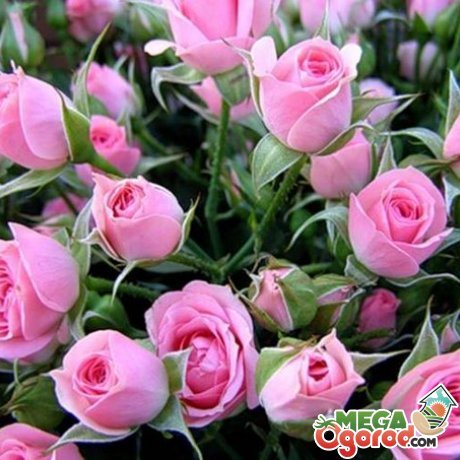

Many believe that the unusually small rose bush came to us from China. But according to historical sources, the cultivation of this plant was started in Switzerland. It was there that they paid attention to the unusual size of the rose and decided to select it. Breeders from Holland, Germany and the USA later joined the Swiss specialists. So the little miracle spread throughout Europe and America. A large number of varieties and types of dwarf roses were bred, in no way inferior in beauty and aroma to an ordinary rose.
The main feature of miniature plants is their size.
It can be a small shrub from 12 to 35 cm in size or a rose with unusual flowering lashes reaching 1 m in length. Dwarf roses can be grown not only in the garden, but also at home - this is the second feature of this unusual plant. Despite the seeming vulnerability of the fragile bush, the rose perfectly tolerates the harsh Russian winters. If the grower decides to grow the plant outdoors, it is preferable to choose frost-resistant species. There are a great many of them.
The dwarf rose, due to its size and lashes, is perfect for decorating borders, verandas, attics and flower beds. Florists plant small bushes against the background of higher flowers - a very spectacular flower meadow is obtained. Landscape designers use dwarf roses to decorate stone embankments or alpine hills, where an ordinary rose would look out of place with its rather tall stems. Features of a dwarf rose allow you to roam the fantasies of a florist and decorate your favorite garden.
Pruning and replanting
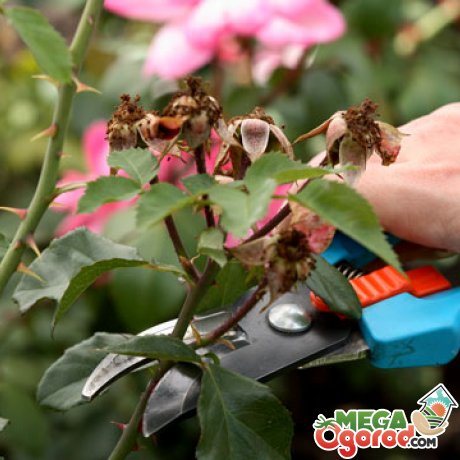

The rose should be pruned in the spring immediately after opening. Remove all dead shoots during hibernation. If necessary, the bush is thinned out. Shoots are cut at an angle above the bud.
It is recommended to leave three to four buds on the stem.
Transplanting a baby rose from a pot into the ground is done in the spring in April-May, depending on the variety. If a rose is planted out of the house into the open ground, you must first take it out into fresh air and leave it outside for some time to adapt. Only after that do they start disembarking. If you plan to plant a rose in the soil in a pot, they act according to the same scheme, but for the winter they dig up the rose and take it to the house. You cannot leave a rose in a pot for the winter, only in the open field.
Pruning and replanting a plant is not a big deal. Gardeners are advised to constantly prune faded inflorescences for their quick set of color again. From a bush, you can cut no more than 2-3 branches with roses for a bouquet or a gift.


